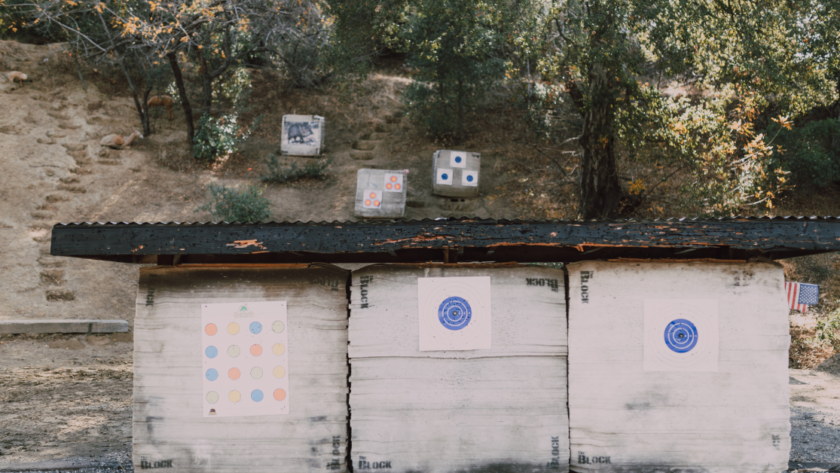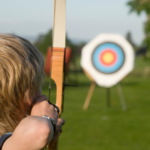I’ve discovered that having a personal archery range in your backyard can improve your practice routine and elevate your skills to new heights. Creating this space involves careful planning, creativity, and a deep understanding of safety protocols.
Let me guide you through the process of setting up your very own backyard archery paradise.
Understanding the Basics
Safety First
Safety forms the foundation of any archery range. A robust backstop capable of stopping arrows that miss or pass through the target is absolutely essential.
I learned this lesson the hard way when one of my early shots sailed over my makeshift target and landed in my neighbor’s yard – thankfully without incident.
Proper backstops should be constructed from materials that can absorb arrow impact effectively. Some excellent options include:
- Tightly packed hay bales
- Rubber horse stall mats
- Specialized archery netting
Your backstop should extend at least 2 feet wider and taller than your target on all sides. This extra coverage confirms that even slightly off-target shots are safely contained.
Space Requirements
While Olympic-sized ranges might be the dream, most backyard setups are more modest in scale. The least recommended distance for target practice is 20 yards.
However, if you have the luxury of space, a 30-40 yard range offers greater versatility in your practice sessions.
Remember that the shooting distance is just one part of the equation. You’ll also need to account for a safety zone behind your targets.
This area should be clear of any structures, valuable plants, or potential hazards.
Legal Considerations
Before you start building, it’s crucial to check your local regulations. Some areas have restrictions on backyard ranges or require specific permits.
I once met an archer who had to dismantle his entire setup because he hadn’t consulted local zoning laws first.
Save yourself potential headaches by making a quick call to your local authorities to confirm you’re in compliance with all relevant regulations.
Designing Your Range
Now that we’ve covered the essential basics, let’s dive into the exciting part – designing your range. This is where you can let your creativity shine while still adhering to practical considerations.
Target Selection
Your choice of targets can significantly impact the quality of your practice sessions. Here are some popular options to consider:
- Foam targets: These are highly durable and make arrow removal easy.
They’re great for consistent practice and can withstand thousands of shots.
- 3D targets: If you’re into bowhunting, these lifelike animal-shaped targets offer more realistic practice.
They help you learn proper shot placement for various game animals.
- Paper targets: Inexpensive and easily replaceable, paper targets are excellent for working on accuracy and scoring your shots.
- Bag targets: Filled with synthetic materials, these targets are lightweight and portable.
They’re ideal for beginners or for quick practice sessions.
I prefer using a mix of target types to keep my practice sessions varied and engaging. This approach helps me work on different skills and prevents boredom from setting in.
Range Layout
When planning your range layout, consider the natural features of your yard. Trees can serve as excellent natural backstops, while slight elevations can add challenging shooting angles to your practice.
Think about the sun’s position throughout the day. You don’t want to be squinting into the glare during your evening practice sessions.
If possible, orient your range so that the sun is at your back during the times you’re most likely to practice.
Consider creating many shooting positions at varying distances. This setup allows you to practice from different ranges without having to move your targets constantly.
Lighting Options
Good lighting can significantly extend your practice hours, especially during shorter winter days. I installed solar-powered LED lights around my range, which serve a dual purpose – they provide lots of illumination for evening sessions and add a pleasant ambiance to the space.
When setting up lighting, confirm that it illuminates both your shooting position and the targets evenly. Avoid harsh spotlights that can create glare or shadows, as these can interfere with your aim.
Implementation: Bringing Your Range to Life
With your design in place, it’s time to roll up your sleeves and start building. Here’s a step-by-step guide to help you through the process:
- Clear the area: Remove any obstacles and confirm a clear line of sight to your targets.
This might involve trimming back some vegetation or relocating garden features.
- Set up your backstop: Whether you’re using hay bales, a dirt berm, or archery netting, make sure it’s sturdy and larger than your target area.
If using hay bales, stack them tightly and cover them with a tarp to protect from the elements.
- Install your targets: Secure them firmly to prevent tipping or movement during use.
If you’re using 3D targets, consider creating a small platform for each one to keep them level and stable.
- Mark your shooting line: Use paint, rope, or even landscaping features to clearly define where you’ll be shooting from.
I used pavers to create a permanent shooting line that also serves as a nice visual element in my yard.
- Create storage solutions: A weather-resistant container or small shed can keep your equipment safe and dry.
I built a small lean-to shed against the side of my house to store my bows, arrows, and other accessories.
- Add finishing touches: Consider adding a bow stand, arrow holders, and a small seating area for comfort during longer practice sessions.
I installed a small bench near my shooting line, which provides a place to rest and also serves as a platform for my equipment.
Overcoming Common Challenges
Even with careful planning, you’re bound to encounter some hurdles. Here are some common issues I’ve faced and how I’ve dealt with them:
Noise Complaints
The thud of arrows hitting targets can be louder than you might expect, especially in quiet neighborhoods. To maintain good relationships with your neighbors:
- Use noise-reducing materials around your targets, such as foam backing or rubber mats.
- Limit your practice to reasonable hours, avoiding early mornings or late evenings.
- Consider inviting your neighbors to try out archery – it might turn them into enthusiasts as opposed to complainers!
Weather Woes
Outdoor ranges are at the mercy of the elements. To mitigate weather-related issues:
- Install a simple canopy over the shooting line to provide shelter from rain or intense sun.
- Use target covers or bring targets indoors when not in use to extend their lifespan.
- Create a small gravel or paved area around your shooting line to prevent muddy conditions.
Maintaining Interest
Even the most dedicated archer can get bored with the same old routine. To keep things interesting:
- Incorporate different types of targets and shooting scenarios.
- Vary your distances and angles regularly.
- Set up friendly competitions with fellow archers or family members.
- Challenge yourself with timed rounds or accuracy games.
Adapting Your Range for Growth
As your skills improve, your range should evolve with you. Here are some ways to keep challenging yourself:
Moving Targets
Once you’ve mastered stationary targets, adding movement to your practice can dramatically improve your ability to judge distance and timing. Consider:
- A simple pendulum target that swings back and forth.
- A target on a pulley system that you can move horizontally.
- A 3D target on a rotating base to simulate a turning animal.
Multiple Shooting Positions
Set up several shooting positions at different angles and distances. This approach:
- Adds variety to your practice sessions.
- Helps prepare you for real-world hunting scenarios or 3D archery competitions.
- Improves your ability to judge distances quickly.
Technology Integration
There are some fantastic archery apps and training tools available that can help you analyze your form and track your progress. Consider incorporating these into your practice routine for a more data-driven approach to improvement:
- Shot tracking apps that record your scores and provide analytics.
- Slow-motion video analysis tools to refine your form.
- Electronic scoring systems for instant feedback on your accuracy.
Building on the Basics
Remember, a backyard range is just the beginning of your archery journey. Use it as a foundation to explore different aspects of the sport:
- Experiment with different bow types and draw weights to find what suits you best.
- Practice various shooting techniques, from instinctive to gap shooting.
- Use your improved skills to join in local archery competitions or clubs.
- Consider taking up bowhunting if it aligns with your interests and local regulations.
Practice Exercises
To make the most of your new range, try these exercises:
The 30-Arrow Challenge
Shoot 30 arrows, aiming for most accuracy. Track your scores over time to see improvement.
This exercise helps build consistency and endurance.
The Walk-Back Drill
Start close to the target and take a step back after each successful shot. This helps you understand how distance affects your aim and improves your distance estimation skills.
The One-Arrow Drill
Take a single shot, then retrieve your arrow. This simulates hunting conditions and improves focus.
It also forces you to make each shot count, just as you would in a hunting situation.
The Timed Round
Set a timer and see how many accurate shots you can make in 2 minutes. This exercise is great for improving speed and precision under pressure, skills that are valuable in competitive archery.
Safety Precautions
Safety should always be your top priority when practicing archery. Here are some essential safety measures to implement:
- Always inspect your equipment before shooting. Look for any signs of wear or damage.
- Never dry fire your bow (release the string without an arrow nocked). This can damage your bow and potentially cause injury.
- Ensure that your shooting area is clear of people, pets, and obstacles before releasing an arrow.
- Store your archery equipment securely when not in use, especially if you have children or pets.
- Wear suitable safety gear, including an arm guard and finger tab or release aid.
- Never shoot an arrow straight up into the air. The falling arrow can be extremely dangerous.
- Be aware of what lies beyond your target. Even with a good backstop, it’s important to know what’s in the line of fire.
Environmental Considerations
Creating an archery range in your backyard also means being mindful of your environmental impact:
- Choose environmentally friendly materials for your backstop and targets when possible.
- Regularly collect and properly dispose of broken arrows or target debris.
- Consider planting native species around your range to create a natural, wildlife-friendly barrier.
- If using artificial lighting, opt for energy-efficient LED options to reduce power consumption.
Maintenance and Upkeep
Regular maintenance will keep your range safe and enjoyable for years to come:
- Inspect your backstop regularly for wear and tear, replacing materials as needed.
- Clean your targets after heavy use to extend their lifespan.
- Keep the shooting area clear of debris and overgrown vegetation.
- Periodically check and tighten any bolts or fasteners on your target stands.
- Repaint or refresh your shooting line and distance markers as they fade.
Expanding Your Archery Experience
While a backyard range is fantastic for regular practice, don’t let it limit your archery experience:
- Join a local archery club to meet fellow enthusiasts and access different types of ranges.
- Participate in local or regional tournaments to test your skills against others.
- Explore different archery disciplines, such as field archery or clout shooting.
- Consider taking an archery coaching course to deepen your understanding of the sport.
The Benefits of Regular Practice
Consistent practice on your backyard range can yield many benefits:
- Improved physical fitness, including better upper body strength and core stability.
- Enhanced mental focus and concentration.
- Stress relief and relaxation.
- Increased confidence as you see your skills improve over time.
- A deeper appreciation for the art and science of archery.
Frequently Asked Questions
How much space do I need for a backyard archery range?
The least recommended space for a backyard archery range is about 20 yards in length, with extra space behind the target for safety. However, more space allows for greater versatility in your practice.
Is it legal to have an archery range in my backyard?
The legality of backyard archery ranges varies by location. Check with your local zoning office or homeowners association for specific regulations in your area.
What’s the best material for a DIY archery backstop?
Tightly packed hay bales, rubber horse stall mats, or specialized archery netting are all excellent choices for a DIY archery backstop.
How often should I replace my archery targets?
The lifespan of archery targets varies depending on the type and frequency of use. Foam targets may last several thousand shots, while paper targets need frequent replacement.
Inspect your targets regularly for signs of wear.
Can I practice archery in the rain?
While it’s possible to practice archery in light rain, it’s not recommended for the sake of your equipment. Moisture can damage bows and arrows, and wet conditions can affect your grip and accuracy.
What’s the best time of day for archery practice?
The best time for archery practice depends on your schedule and lighting conditions. Many archers prefer early morning or late afternoon when the light is softer and temperatures are cooler.
How can I improve my accuracy in archery?
Improving accuracy in archery comes from consistent practice, proper form, and attention to detail. Focus on maintaining a steady anchor point, smooth release, and follow-through with each shot.
Are there any age restrictions for backyard archery?
There are typically no legal age restrictions for backyard archery, but children should always be supervised by a knowledgeable adult when practicing.
What type of bow is best for beginners?
For beginners, a recurve bow or a basic compound bow with adjustable draw weight is often recommended. These allow for proper form development and can be adjusted as the archer’s strength improves.
How can I make my backyard archery range more challenging?
To increase difficulty, try varying your shooting distances, adding moving targets, or incorporating obstacles that simulate hunting scenarios.
Key Takeaways
- Prioritize safety with a proper backstop and clear shooting lanes
- Check local regulations before building your range
- Design your range to fit your space and skill level
- Incorporate variety in targets and practice routines to maintain interest
- Use your backyard range as a stepping stone to broader archery experiences



